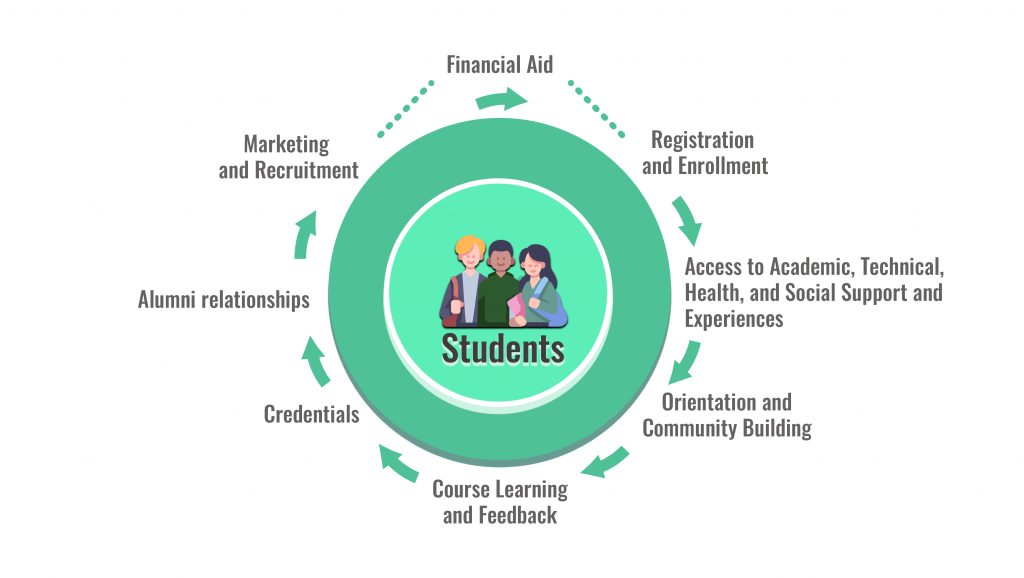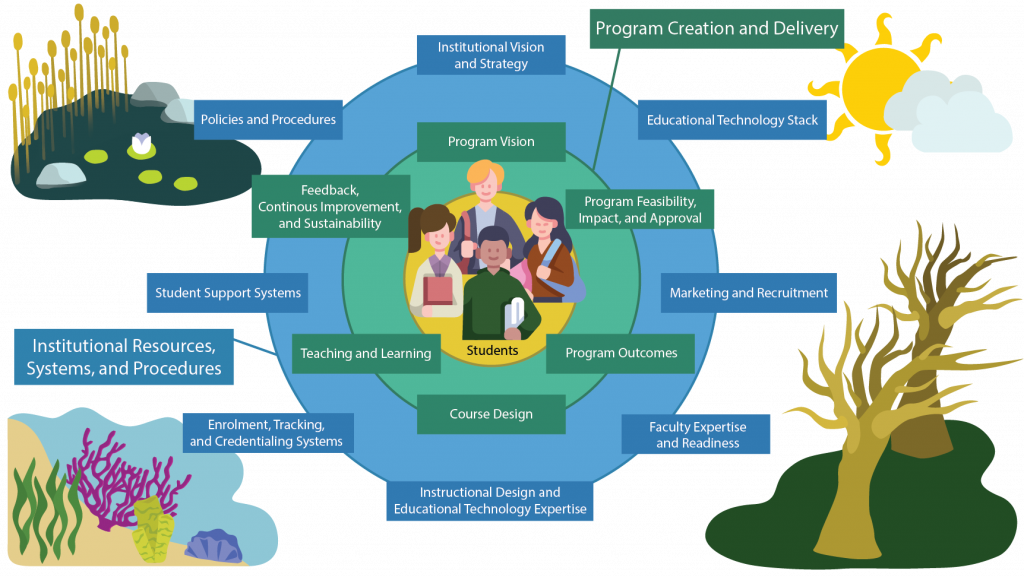Module 4: Building Sustainable Online Programs
Sustainability and Online Programs
Denise Stockley
In this unit, we return to the ideas from Module 1, Collaborating to Create the Online Student Life Cycle and its Ecosystem and view them through a sustainability lens. While we have positioned this module on program sustainability as our final module to collectively highlight practices and tools that can assist you in this vital part of program design, we want to emphasize the importance of thinking about sustainability from the very beginning of your program development work.
Sustainability planning must be a forethought instead of an afterthought, which requires proactive planning prior to launching any program. While you may understandably be focused on getting your program “up and running,” there are important processes that you can embed in the design and implementation phases of your program that will help you know if you have met your vision and goals for the program and where you will need to dedicate resources for continuous improvement to ensure the long-term success of your program and its students.
Learning Outcomes
By the end of this Unit, you will be able to:
- Recognize the importance of embedding sustainability in the program design process
- Apply a sustainability lens to the process of designing and implementing your program
You will take away:
- Knowledge of areas within your own institution that currently promote sustainable program development and where sustainability efforts need to be developed


Sustainability Defined and In Action
Sustainability is defined simply as being, “able to last or continue for a long time” (Merriam-Webster, n.d.). This definition sounds straightforward, but it doesn’t necessarily speak to the quality or health of your program. It may be more helpful to think of sustainability as the result of a well-functioning ecosystem, where every part of the visioning, development, and implementation of an online program interconnects to support the student life cycle and ensure program longevity and currency. As with all ecosystems, the health and functioning of one element and how it interconnects with the others can affect how sustainable the environment is and who thrives within it.
Once your program is up and running, how will you know that the program is meeting the vision that you set for it? How will you know if the online ecosystem around it is effectively supporting your students as they move through the online life cycle? How will you know that it is meeting the needs of the department, institution, or other community stakeholders who helped shape the purpose and vision of the program? As time passes, how will you assess what elements need to be changed, refined, or remain the same to ensure program effectiveness and longevity? And what resources do you have available to respond to any of this work after the program launches?
Sustainability planning helps leaders meet the future challenges and opportunities related to the program, and it should be part of online program design and implementation work. It’s critical for program leaders to be aware of how sustainability planning can be incorporated at each stage in the process. This means not solely relying on external cyclical review processes to set the timeline and requirements to determine sustainability, but rather creating a program sustainability plan. Each of the areas in the online program ecosystem and their effects on the online student life cycle should be planned out with a vision of at least 5 years into the future, rather than focusing just on the program launch.
The following video provides an overview of sustainability and the importance of planning within online programs from one leader’s perspective.
In the video, Patrick prioritizes program sustainability in their context around long-term planning for updating course content and methods of teaching. Certainly, this is an important area of sustainability planning that will likely be consistent around any online program because of the nature of online course design and improving technology. You may also identify that there are other important areas that your program will need to consider for sustainability, for example, if one of your visions for the program is incremental enrolment of 15% over 4 years, will you be able to meet increased demand for academic counselling or the application interview process? If you want your program to be accessible to equity-deserving students who have previously faced barriers to institutional access, will the collaborative units that support this initiative still be able to contribute their expertise and resources past the program launch date? Do you want to incorporate state-of-the-art technology into a set of courses that will require extra resources from the institutional Information Technology Unit? These are just a few examples of where long-term planning for sustainability reaches out across the online ecosystem. Revisiting your Program Vision can help you determine your sustainability planning and prioritization. Let’s turn our attention to how you can use your program context to start visioning where your sustainability plan might take you.
Visioning Sustainable Online Programs
Before we go further in thinking about online program sustainability, it is worth pausing to note that “sustainability” in relation to any post-secondary program has historically been framed by the concept of “Quality Assurance.” Since 2002, under the Colleges of Applied Arts and Technology Act, Ontario colleges have been mandated to develop a process that focused on quality within their programs. This Act resulted in the creation of an institutional and provincial quality assurance process that is self-regulated by the colleges through an arm’s length oversight and governance body: the Ontario College Quality Assurance Service (OCQAS). Within the guiding principles for the OCQAS, the final principle focuses on sustainability, stating that programs must be “be sustainable and affordable for the system as a whole and for the individual colleges in the system.” In the university sector, quality assurance processes came into effect in 2010 with the creation of the Ontario Universities Council on Quality Assurance. Similar to the college sector, this organization is at arm’s length and it is intended to assure quality and sustainability in both new and existing programs.
By keeping these two quality assurance frameworks (College and University) in mind, institutions and their leaders can take an active role to ensure the creation and implementation of high-quality sustainable online programs. But it can be challenging to know where to start or how to navigate the quality assurance system as a leader given that online programs require a combination of both traditional and new areas expertise, resources, roles, and administrative planning. It’s our hope that the information presented here and in the remainder of this module will enable you to consider the entire online ecosystem when thinking about sustainability regardless of any quality assurance reporting so that, when it comes time to engage in institutional quality assurance processes, your sustainability plan will serve as a guide to completing the part of that process rather than the quality assurance process being the sole reason you consider sustainability. Having conversations about sustainability at the end of the program design and implementation process rather than fully integrating them throughout leaves your program vulnerable to both inside and outside forces that may undermine its success.
Building sustainability into the conversation from Day 1 of planning and at each step afterward is essential. In Module 2, Creating an Aligning Program Vision, you were challenged to respond to these questions:
- Why is this program important?
- What are the unique advantages of the program—what makes it distinctive?
- How does the program contribute to the needs of the university or college community and the broader local, provincial, and global community?
- How do we define success in this program, and how will we know that the program has been successful (what metrics will you use)?
- Why online? What is your rationale for developing an online program specifically?
As you will notice, there are no questions relating to failure or lack of success. We build a vision around possibility, and as our colleagues Anstey and Haque (n.d.) suggest, you want our vision to SOAR by reflecting the Strengths, Opportunities, and Aspirations identified by your collaborators and stakeholders to get the Results you hope for.
However, building an online program on vision alone would not move beyond the feasibility and approval stage without demonstrating that the program is sustainable and useful in a way that meets the institutional approval process, because institutions have limited and competing resources. Building sustainability, like program and course design, should follow a collaborative process, ensuring that key stakeholders and units that inform and create the online ecosystem (such as those described in Module 1) are engaged and contribute to the success of the program. Taking a systems approach ensures that the big picture isn’t lost as we plan for the future.
To promote sustainability, we need to think about the big picture or vision as to why we are developing the online program. The following image includes six prompting questions to aid you in your reflection, which encompasses various areas to consider when planning your programs.

Activity 1: Respond to the six prompt questions above to start considering how your initial program vision can help you begin thinking about program sustainability. You can document your responses in the Program Development and Implementation Workbook.
Now that you’ve started thinking about where your program “journey” originally began and where your intended destination is, as well as the resources and collaborators along the way, let’s go back to thinking about the elements of the online ecosystem that support your program. The goal here is for you to identify, in relation to your program vision and outcomes, those areas of the online ecosystem that you believe you will have to develop a long term (e.g., 5-year) plan for ongoing collaboration and/or resourcing to gather information about the effectiveness of your program and its ongoing improvement and sustainability.
Unit Reflection
In this unit, you have:
- Recognized the importance of embedding sustainability in the program design process
- Begun to apply a sustainability lens to the elements of the online program ecosystem in your program
Hopefully, this unit has highlighted what you already do with regard to creating sustainable programs and has got you thinking about what you can do to promote/improve the sustainability of your programs. The next step is to start visioning what form your program sustainability plan will take, then assess how ready your institution and/or department is to create and implement it.

